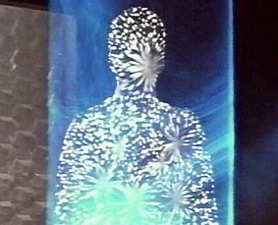 We may never be able to teleport ourselves "Star Trek"-style, but scientists managed to transmit information a record distance using entangled photons.
We may never be able to teleport ourselves "Star Trek"-style, but scientists managed to transmit information a record distance using entangled photons.
Scotty won't beam anybody anywhere anytime soon, but a new report by Chinese scientists shows that it is possible to transmit information over long distances using quantum entanglement. The research, published in the current issue of the journal Nature Photonics, could lead to faster and smaller quantum-based computers and unbreakable, encrypted communication across the world.
We may never be able to teleport ourselves "Star Trek"-style, but scientists managed to transmit information a record distance using entangled photons.
Scotty won't beam anybody anywhere anytime soon, but a new report by Chinese scientists shows that it is possible to transmit information over long distances using quantum entanglement. The research, published in the current issue of the journal Nature Photonics, could lead to faster and smaller quantum-based computers and unbreakable, encrypted communication across the world.
The team reported they were able to "teleport" information 16 kilometers, or 9.9 miles.
"This is the longest reported distance over which photonic teleportation has been achieved to date, more than 20 times longer than the previous implementation," said Cheng-Zhi Peng, one of the co-authors of the study and a scientist at University of Science and Technology of China and Tsinghua University in Beijing.
In science fiction, teleportation usually describes the transfer of matter from one point to another, more or less instantaneously. In real physics, it's considered part of the "spookier" aspects of quantum mechanics (as Einstein famously derided the nascent field), that describes the behavior of the atoms and their constituent particles.
According to the theory, bits of light and matter can become entangled with one another and anything that happens to one particle will happen to the other, regardless of the distance or intervening matter. What the Chinese scientists managed to do was transmit change-of-state information from photon to photon over a distance of 16 kilometers.
In the past, scientists have had trouble separating entangled particles by more than several hundred yards; the particles become un-entangled, and what happens to one particle doesn't happen to the other particle.
In their new experiment, the Chinese scientists managed a quantum leap forward for quantum teleportation.
Using a blue laser, a semiconductor, and a beta-barium borate crystal, the scientists first entangled two photons of light. Next, they sent one photon, which had slightly more energy, through about 10 miles of free space, from
The sheer distance the Chinese scientists teleported a photon's information is very impressive, said Benjamin Schumacher, a physicist at
Ten miles is far enough to start thinking about a next-generation satellite communications network based on quantum teleportation, said both Schumacher and Peng.
Teleportation-based telephone calls wouldn't travel any faster than existing networks, said Schumacher. Entangled information arrives faster than the speed of light, but to read it scientists would need a key to decode the information, which would arrive using traditional communication at slower-than-light speeds.
 However, a teleported telephone call would be impenetrable. Unlike radio waves, which send out a signal that enemies can pick out, eavesdropping on a teleported telephone call would be impossible. The two particles are entangled with themselves and no other particle so the quantum mechanical equations simply do not allow it, said Schumacher.
However, a teleported telephone call would be impenetrable. Unlike radio waves, which send out a signal that enemies can pick out, eavesdropping on a teleported telephone call would be impossible. The two particles are entangled with themselves and no other particle so the quantum mechanical equations simply do not allow it, said Schumacher.
Even if someone managed to monitor an entangled particle, they would need a key, transmitted over traditional communication channels, to interpret the information.
The research could also dramatically speed up computing power. Quantum computing, using entangled particles, has been a dream of physicists for decades. Such computers would be vastly more powerful than existing electronics, and transmitting information across entangled particles with 89 percent accuracy, as the Chinese team managed, is a big step toward quantum computing.
A communications system named after a "Star Trek" trick might seem futuristic, but practical ground-to-satellite teleportation could be in place in as little as two years, said Schumacher.
That's exactly what the Chinese scientists hope to try over the next few years, said Peng.
With sophisticated telescopes, radar and a low-Earth orbit satellite, the Chinese scientists expect to be able to teleport information from Earth to a spacecraft and back down to Earth.
Scotty would be impressed.

 Previous page
Previous page Back to top
Back to top







